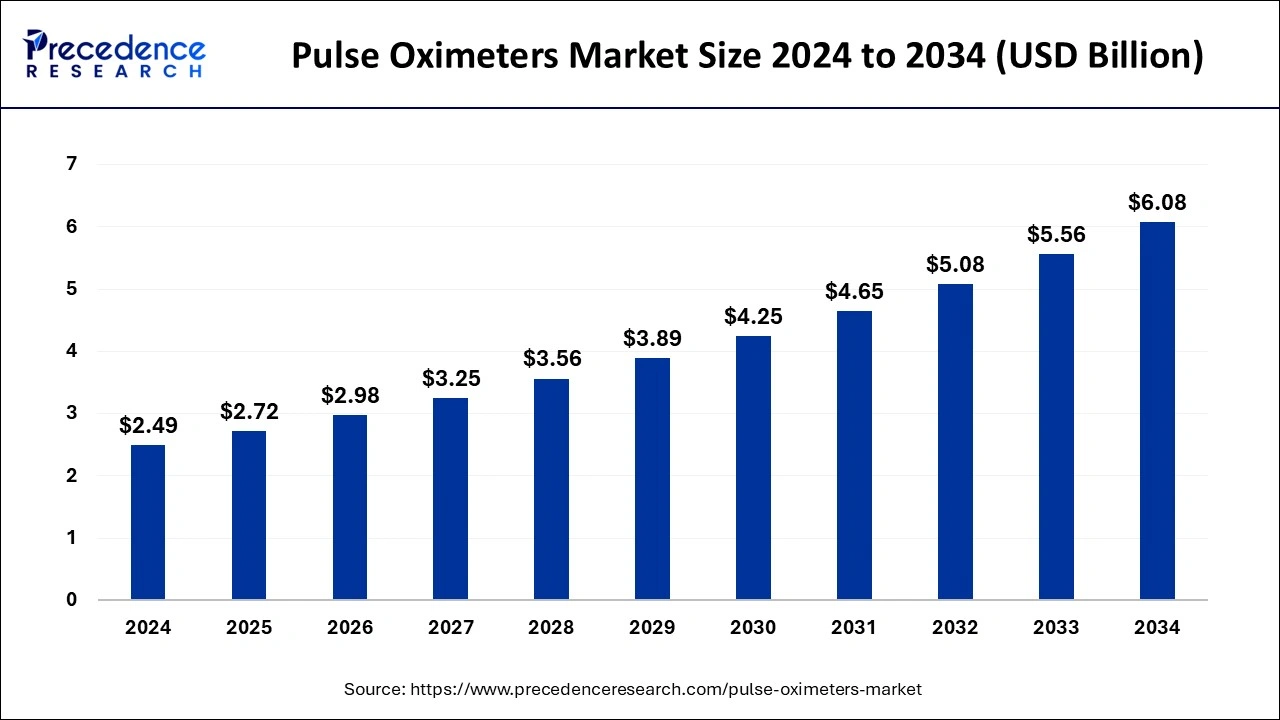Pulse Oximeters Market Size to Surge Around USD 6.08 Bn by 2034
Pulse Oximeters Market Size and Growth 2025 to 2034
The pulse oximeters market size was calculated at USD 2.49 billion in 2024, and it is projected to be surge around USD 6.08 billion by 2034 with a CAGR of 9.33%.

Get Sample Copy of Report @ https://www.precedenceresearch.com/sample/1036
Key Insights
- In 2024, North America held the largest share of the market at 49%.
- The hospitals segment was the top contributor in the market by end-use.
- The home healthcare segment is expected to grow at the highest CAGR over the forecast period.
- Tabletop oximeters had the highest market share among product types in 2024.
The Role of AI in Transforming the Pulse Oximeters Market
The integration of artificial intelligence in pulse oximeters is enhancing their accuracy and reliability. AI-powered algorithms help in minimizing errors caused by skin pigmentation, motion artifacts, and ambient light interference.
Additionally, AI enables predictive analytics, allowing healthcare providers to detect early signs of respiratory distress or other complications. With continuous advancements, AI-driven pulse oximeters are becoming more effective in remote patient monitoring, telemedicine, and personalized healthcare solutions.
Market Drivers
The growing prevalence of respiratory diseases such as COPD, asthma, and pneumonia is driving the demand for pulse oximeters worldwide. The increasing adoption of remote patient monitoring and telehealth services is further accelerating market growth, as pulse oximeters enable real-time tracking of oxygen saturation levels.
Additionally, rising health awareness and the growing preference for home healthcare devices are pushing manufacturers to innovate and introduce advanced AI-powered pulse oximeters. The expansion of healthcare infrastructure in emerging economies is also contributing to the increasing adoption of these devices.
Opportunities
Technological advancements in pulse oximeters, such as the integration of artificial intelligence, wireless connectivity, and cloud-based monitoring, are creating significant opportunities for market expansion.
The increasing focus on wearable health devices presents a lucrative opportunity for manufacturers to introduce smart pulse oximeters that seamlessly connect with smartphones and other digital platforms. Moreover, government initiatives promoting healthcare accessibility and chronic disease management provide a favorable environment for market growth.
Challenges
Despite the promising growth, the pulse oximeters market faces challenges such as accuracy concerns due to factors like skin pigmentation and motion artifacts. The presence of counterfeit and low-quality products in the market poses a risk to consumer trust and safety.
Additionally, stringent regulatory approvals and compliance requirements can delay product launches and hinder market entry for new players. The high cost of advanced pulse oximeters may also limit their adoption in price-sensitive regions.
Regional Insights
North America dominates the pulse oximeters market due to the strong presence of healthcare facilities, high adoption of advanced medical technologies, and growing awareness about chronic respiratory diseases. Europe follows closely, with increasing investments in digital health and rising demand for home-based monitoring devices.
The Asia-Pacific region is expected to witness the fastest growth, driven by a large patient population, expanding healthcare infrastructure, and rising healthcare expenditure. Meanwhile, Latin America and the Middle East & Africa regions are experiencing gradual growth due to improving healthcare accessibility and increasing awareness about preventive healthcare solutions.
Pulse Oximeters Market Companies
- Smiths Group plc.
- Halmaplc
- Koninklijke Philips N.V.
- Medtronic plc
- Nihon Kohden Corporation
- Masimo Corporation
- Contec Medical Systems Co., Ltd.
- Omron healthcare, Inc.
- General Electric Company
- Nonin Medical, Inc.
Leadership Announcement
Prevounce Health comes as one of the leading providers of software for remote care management by announcing its first blood oxygen device under the venture of remote patient monitoring (RPM): Pylo OX1-LTE. According to Daniel Tashnek, founder and Chief Executive Officer of Prevounce, this device was an exciting addition to the Pylo family.
Even as the device delivers actionable data to clinicians for empowering care, it will be allowed to be used much more easily by patients. This will ensure increased involvement and participation in RPM programs while reducing both clinician and technical support work needed to scale up remote monitoring programs.
Recent Developements
- In January 2025, the United States Food and Drug Administration released guidelines for manufacturers regarding the calibration of their devices to better read pulse oxygen readings for people of color, by ensuring devices are tested across a variety of skin tones. The new guidelines ask companies to mandate the collection of 3,000 data points rather than 200. Studies conducted using these meters will also need to be composed of a minimum of 10 people, with 150 being the recommended sample size.
- In August 2024, Prevounce Health, a leading medical device provider, launched a remote patient-monitoring blood oxygen measurement device called Pylo OX1-LTE. The device is cellular connected, offering secure data collection, reliability and improved connectivity. The device is cost-effective, making it easier for organizations to invest in growing their remote patient monitoring programs.
Segments Covered in the Report
By Product Type
- Handheld Oximeters
- Fingertip Oximeters
- TabletopOximeters
By End-user
- Ambulatory Surgical Centers
- Hospitals
- Home Healthcares
By Regional Outlook
- North America
- U.S.
- Canada
- Europe
- U.K.
- Germany
- France
- Asia Pacific
- China
- India
- Japan
- South Korea
- Rest of the World
Ready for more? Dive into the full experience on our website@ https://www.precedenceresearch.com/
